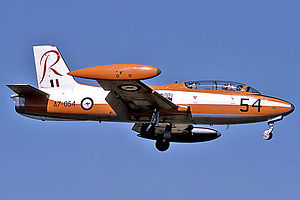Embraer AT-26 Xavante
| MB-326 | |
|---|---|
 |
|
| RAAF Aermacchi MB-326H A7-054 landing at RAAF Base Edinburgh (November 1986) | |
| Role | Advanced trainer/Light attack |
| Manufacturer | Aermacchi |
| First flight | 10 December 1957 |
| Introduction | February 1962 |
| Status | Limited service |
| Primary users |
Italian Air Force South African Air Force Brazilian Air Force Royal Australian Air Force |
| Produced | 1961–1975 |
| Number built | ~800 |
| Variants | Aermacchi MB-339 |
The Aermacchi or Macchi MB-326 is a light military jet aircraft designed in Italy. Originally conceived as a two-seat trainer, there have also been single and two-seat light attack versions produced. It is one of the most commercially successful aircraft of its type, being bought by more than 10 countries and produced under licence in Australia, Brazil and South Africa. It set many category records, including an altitude record of 56,807 ft (17,315 m) on 18 March 1966. More than 600 were built.
In the 1950s, a number of countries were operating small jet trainers with a similar performance to their operational aircraft. At this time, several nations commenced development of purpose-built aircraft for the role, such as the Fouga Magister, the T-37, the Jet Provost, and the Aero L-29. Italy, which was still recovering from the effects of the Second World War, could not afford the development of supersonic interceptors or bombers; it instead elected to focus its development efforts on light fighter and trainer aircraft.
The MB-326 was designed by Ermanno Bazzocchi at Macchi. Bazzocchi considered many configurations before it was chosen to proceed with a single-engined design. The airframe was a robust and light structure, all-metal, simple and cheap; powered by an efficient engine, the Armstrong Siddeley Viper. This engine was designed as a short-life unit originally destined for target drones, but showed itself to be far more reliable. This airframe and engine combination led, in 1953, to the MB-326 project.
The Italian Air Force was quite interested, and so the MB-326 took part in the contest.
The contest specifications were:
There were several modifications to the MB-326 project: the horizontal tail surfaces lost their negative dihedral angle, the airbrakes (two in the wings) became one, in the ventral position. In 1956 the AMI approved the project and requested two prototypes (MM.571 and 572) and one airframe for static tests. No weaponry or pressurization was needed, but Bazzocchi introduced them.
...
Wikipedia
